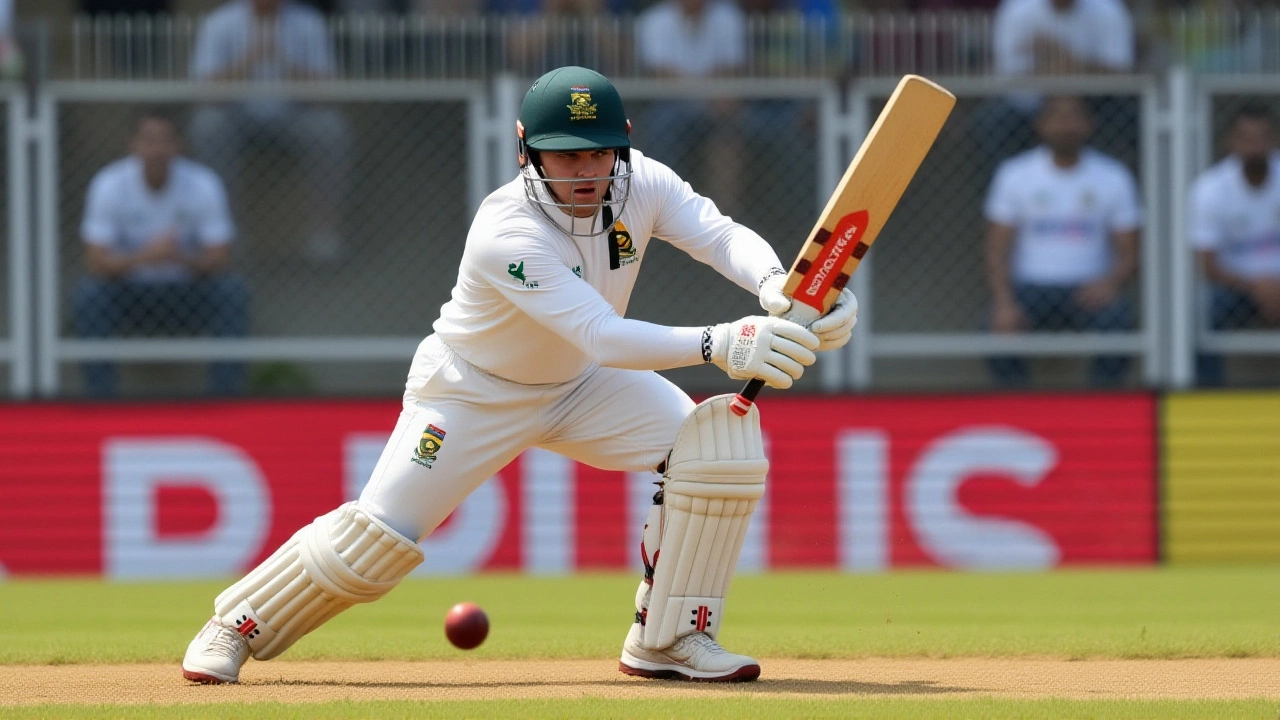Muthusamy’s maiden century and Jansen’s 93 propel South Africa to 489 against India in Guwahati

When Senuran Muthusamy stepped off the field after scoring his maiden Test century, the crowd at Barsapara Stadium in Guwahati rose as one—not just for the runs, but for the story behind them. It was 10:37 AM UTC on Sunday, November 23, 2025, and South Africa had just posted 489 all out against India on Day 2 of the second Test. The innings, built on grit, grace, and quiet brilliance, wasn’t just about numbers. It was about identity, legacy, and the quiet power of discipline.
A century born of discipline, not drama
Muthusamy, a left-handed batter and left-arm spinner of Indian heritage, began the day on 25. By lunch, he was on 56. No fireworks. No showboating. Just a textbook lesson in concentration. He faced 165 minutes for his first 50, and when he reached it, the commentary team noted he’d "hardly put a foot wrong." One edge to the keeper prompted a review—but the ball had brushed his glove, not the bat. He survived. He kept going. His second 50 came in just 71 balls. That’s when the acceleration began. A perfectly timed sweep through midwicket. A brutal hook over fine leg. A four past point, "waited on it and has found the gap," as one commentator put it. He reached 98 with a boundary, and then, with a single to square leg, he brought up his century. The crowd erupted. The Indian bowlers looked exhausted. His innings ended at 109, top-edging a sweep to fine leg, where the ball landed straight into the gloves of the fielder. He walked off to a standing ovation.Jansen’s dazzling 93 and the all-rounder synergy
While Muthusamy anchored the innings, Marco Jansen lit it up. His 93—career-best in Test cricket—was pure, unadulterated aggression. He carved boundaries through the off side, punished loose deliveries with brutal effect, and looked every bit the modern all-rounder. For a while, it seemed he might reach a century of his own. But as he neared triple figures, he slowed, conserving energy, knowing the tail needed support. He partnered with Keshav Maharaj, another left-arm spinner of Indian descent, to add 58 quick runs after Muthusamy’s dismissal. The runs came thick and fast. South Africa added 58 in just 14 overs after the eighth wicket fell. The synergy between Muthusamy and Maharaj isn’t coincidental. Both are sons of Indian families raised in South Africa. Both carry cultural roots that run deep—Muthusamy visits temples regularly; Maharaj, too, speaks of his faith shaping his calm under pressure. Together, they’re dismantling the myth that India’s home conditions are impenetrable. "They’re not just playing cricket," says former teammate Imraan Khan. "They’re rewriting what it means to be South African cricketers in India."
India’s mountain to climb
By stumps, India had reached 9 for no loss. But make no mistake: this is a mountain, not a hill. South Africa’s 489 is their highest total in India since 2010. The last time they won a Test in India was in 2015. They’ve now won the first two Tests of this series, with the second match looming as a potential series-clincher. India, still reeling from a 30-run loss in Kolkata, now face the reality that their batting, which looked solid in the first Test, has cracked under pressure. The spin duo of Harmer and Maharaj—both of whom bowled 40-plus overs on Day 2—will be licking their lips. According to SuperSport’s Neil Manthorp, "Muthusamy’s maiden Test century and a dazzling, career-best 93 from Marco Jansen put South Africa in complete control." And control is exactly what they’ve seized. India’s spinners, who usually dominate on these pitches, were taken apart by Muthusamy’s footwork and Jansen’s timing. The pitch, though slow, offered enough turn for the bowlers to be dangerous—but not enough to stop two batters who knew how to play it.A legacy beyond the boundary
Muthusamy’s journey is as compelling as his innings. Born in Durban, raised by a single mother who worked two jobs to keep him in cricket gear, he lost his father at 11. A cricket fanatic, the elder Muthusamy had once dreamed of playing for India before settling in South Africa. His son carries that legacy quietly—yoga every morning, temple visits on match days, and a degree in social science from the University of KwaZulu Natal, specializing in media and marketing. "He would have made something of his life even if cricket didn’t work out," says The Indian Express. And yet, here he is: the man who dismissed Virat Kohli on his Test debut in 2019, and now, the man who silenced a packed Indian stadium with a century built on patience, not power. This isn’t just about a match. It’s about representation. It’s about what it means to be a South African of Indian descent playing in India—and winning. Muthusamy doesn’t need to prove his loyalty. He’s already shown it. In his technique. In his temperament. In his tears after the century.
What’s next?
India must bat out Day 3 to avoid the follow-on. But even if they survive, they’ll need to bat for three days to win. South Africa’s lead is too big. Their bowlers are too sharp. And their batters? They’re just getting started.Frequently Asked Questions
How significant is Senuran Muthusamy’s century in the context of South Africa’s history in India?
Muthusamy’s 109 is South Africa’s first Test century in India since 2019 and only the 12th by a South African batter on Indian soil since 2000. It’s the highest individual score by a South African in Guwahati, and the first century by a South African in a Test in Assam. His innings helped South Africa post their highest total in India in 15 years, making it one of the most pivotal knocks in their recent away history.
Why is the partnership between Muthusamy and Keshav Maharaj symbolically important?
Both players are of Indian heritage but represent South Africa—a rare and powerful dynamic in international cricket. Their partnership on the field mirrors a broader cultural bridge. Muthusamy’s family is from Tamil Nadu; Maharaj’s ancestors are from Gujarat. Together, they’ve become symbols of dual identity in sport, challenging the notion that Indian-origin players must choose one side. Their success in India is a quiet rebuke to nationalism in cricket.
How did Marco Jansen’s batting style differ from Muthusamy’s in this innings?
While Muthusamy played with surgical precision—defensive technique first, then calculated aggression—Jansen attacked from the outset. He hit 12 fours and 4 sixes, often clearing the infield with straight drives and pulling spinners over midwicket. Muthusamy faced 209 balls; Jansen faced 142. One was a masterclass in control; the other, a display of fearless power. Together, they balanced the innings perfectly.
What does this result mean for the series?
South Africa now leads 2-0 after winning the first Test by 30 runs in Kolkata. With India facing a 480-run deficit and only two matches left, a draw in Guwahati would still leave South Africa with an unassailable lead. Winning the series in India—especially after losing the 2022 series 3-1—is now within reach. No South African team has won a Test series in India since 2006.
Is this Muthusamy’s breakthrough, or has he been underrated all along?
He’s been underrated. Muthusamy has 10 first-class centuries and has been a mainstay in South Africa’s domestic 4-Day series since 2016/17. But his Test career has been inconsistent—until now. His 2019 debut included taking Virat Kohli’s wicket, yet he was dropped after just two Tests. His return in 2025, at age 28, wasn’t expected to be this impactful. This innings isn’t a fluke—it’s the culmination of a decade of quiet excellence.
How has the Indian media reacted to Muthusamy’s performance?
The Times of India called his knock "built on discipline rather than risk," while The Indian Express highlighted his cultural duality with a feature titled "The South African Who Prays in Temples." Many commentators noted the irony: a player of Indian origin, raised on Indian cricketing values, outplaying India’s own bowlers on home soil. Some called it poetic; others, unsettling. But no one called it luck.

